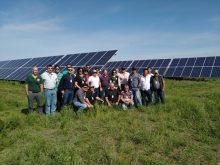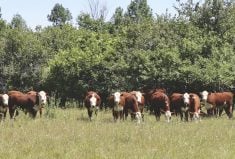If you’re a producer who has recently decided to install a solar photovoltaic (PV) array on your farm or ranch, your timing is right.
Under the Alberta Agriculture and Forestry On-Farm Solar Voltaics Program, the provincial government is offering to cover up to 35 per cent of costs for producers building on-farm, grid-tied solar systems.
However, at some point in the design process, you will need to have a feasible plan that satisfies the program’s criteria — and yourself.
And that means asking some big questions, including: Is the building I’ve chosen appropriate for mounting a solar array or could it collapse under its weight? Should I mount the array on the roof of a farm building or on the ground? How should I angle my modules so they capture the most sunlight?
Read Also

Farming Smarter receives financial boost from Alberta government for potato research
Farming Smarter near Lethbridge got a boost to its research equipment, thanks to the Alberta government’s increase in funding for research associations.
One of the prerequisites of receiving provincial funding is hiring a qualified solar contractor. (The Solar Energy Society of Alberta has a detailed list of solar providers on its website.)
However, that’s just a start, said Erika Grintals and Bryce Allred of Lethbridge-based solar company Solar Optix Energy Services.
Hiring a contractor with strong engineering support is key to answering questions about array placement and optimization, they said. Without an engineer, your plan — even if designed by a professional company — may amount to guesswork. And as more and more people of variable skill and credentials enter the solar industry, there’s no guarantee the contractor you’ve hired will have access to this crucial input.
“When clients are looking for a contractor, they need to know the kind of data the company is offering in their proposal,” said Grintals.
“If it’s just a printoff that says, ‘Here’s your stuff, here’s the price tag — enjoy that,’ you’re not getting a design, you’re not getting 12 months of weather data, and you’re not getting an estimate of what you’ll produce in December versus what you’ll produce in July. You need to be able to look at those numbers and know that they’re not inflated and overpromising.”
Not all roofs fit for solar
Farm buildings occupy a unique space in the province’s building regulations. The Alberta Building Code provides an exemption for most farm buildings which means, for all intents and purposes, there is no enforceable code on a provincial level. Although the National Farm Building Code offers a non-mandatory “model code” that outlines baseline construction standards for farm buildings, Alberta has not adopted this code. (Local municipalities, however, may have their own regulations.)
From Solar Optix’s perspective, it’s not necessarily enough for a farm building to be built ‘to code’ in order for it to be suitable for a solar array mount.
“Both fortunately and unfortunately, in Alberta it’s up to the designer and installer to use their judgment to determine if a roof is suitable,” said Allred.

This means looking at basic construction values such as sufficient truss and purlin spacing and the gauge and thickness of the roof.
“If it’s an old 70-year-old barn and it’s got a swayback like a horse, we’re obviously not going to put a solar array on it. If the shingles are worn out we won’t install it. If there’s anything questionable we’ll tell the farmer we need to have a structural engineer survey the building or we won’t install it. Often, if we have any questions about roof loading we’ll call the contractor who built it.”
Brand new buildings ‘built to code’ do not get an automatic pass under Solar Optix’s standards.
“A lot of the prefabricated, pre-engineered buildings are built to minimum code because it’s a cost saving,” said Allred. “I’ve seen brand new buildings built to minimum code on which we can’t even add five pounds per square foot because the roof won’t support it.”
The material the roof is constructed from is generally less important than how the solar array is installed and how well the building is constructed, said Allred.
“We always try to attach to the structure rather than to the sheathing on the structure. We always go right through to the structure itself — to a truss, to a beam, those kind of things. That’s just good building practice. You can buy metal hooks and clamps that can hook on to the profile of a metal roof but they’re only as good as how the metal on the roof was installed.”
Think solar before building
But what if you’re designing a new farm building on which you might install a solar array someday?
There are ways to optimize the process right at the design stage, said Grintals.
“If they have a choice to face the building due south, that’s ideal. The truss spacing, purlin spacing and the size of the roof obviously have to be adequate for the size of solar system you’re planning.”
Adds Allred, “If you have venting or HVAC penetrations you want to design around those so you have the best roof space to design for solar.”
Ground versus building
One of the most basic — but nevertheless crucial — questions to ask is whether to install a solar array on a building or on the ground. Although installing on the roof of an existing building is often more economical, ground mounting is more flexible.
“With a ground structure you build it where you want and set the angle of the solar modules where you need them,” Allred said. “When you have an existing building, it is what it is and you get what you get. A lot of the decision is about choice and what buildings are available.”
New technology has also made ground mounting more attractive, said Grintals.
“There are newer products on the market like bi-facial modules which produce solar power from the irradiance on the back side of the modules. They produce electricity really well with a particular kind of racking on a ground mount but they don’t work as well — or wouldn’t be used at all — on a roof.
“We had a customer last fall who chose to do a ground-mounted installation with bi-facial modules and his production has well surpassed all of our estimates.”
What’s your angle? That depends
The optimal angle of a solar array depends a lot on where you live, said Allred. An experienced contractor will help clients identify that data and adjust the system accordingly.
“As you move farther north or south your optimal angles change based on latitude. In Edmonton, you would want your modules on a different tilt than you would in Sweetgrass (in northern Montana) or Coutts (in southern Alberta).”
In the Lethbridge area where Solar Optix is headquartered, Allred finds a 35- to 40-degree angle optimal for both production and natural snow removal.
Speaking of snow, Solar Optix factors projected snow days based on historical weather data into its computer modelling program when designing a system. This gives the client an idea of how many days out of the year the system may be inactive, said Grintals.
“We build into the equation the fact there may be snow cover for 50 per cent of the month of January,” she said. “We include that so the client doesn’t have to be concerned about getting up on their roof and cleaning off the modules.”
















